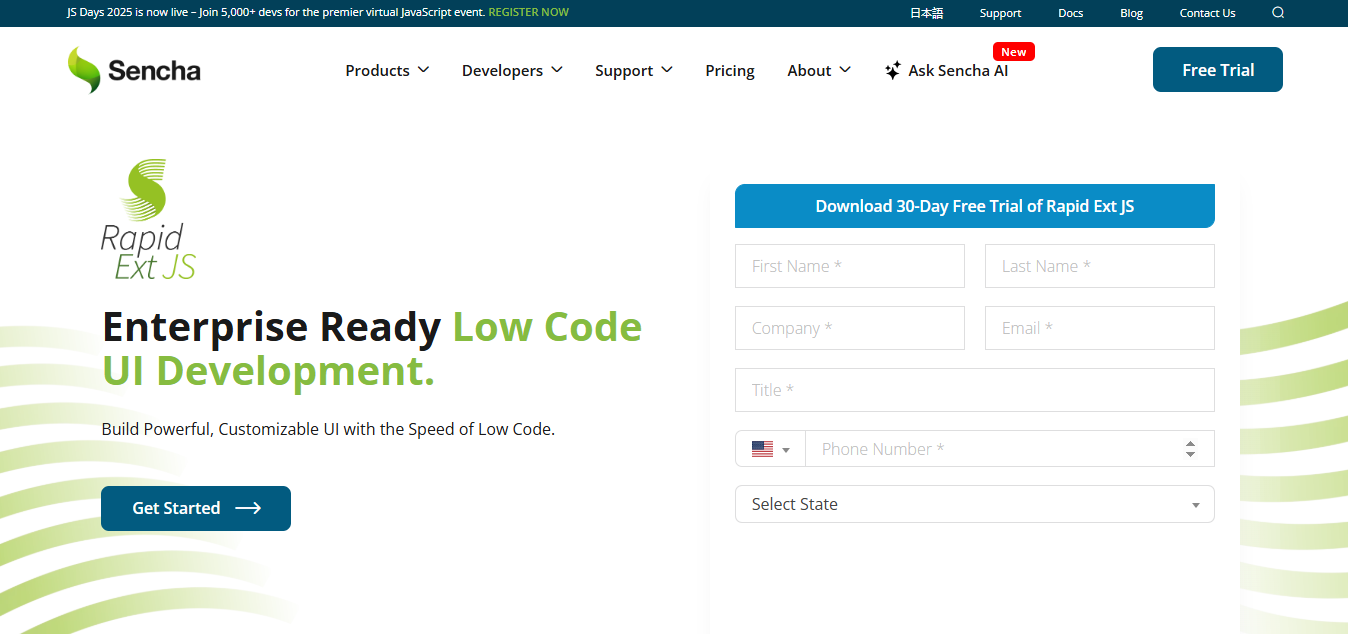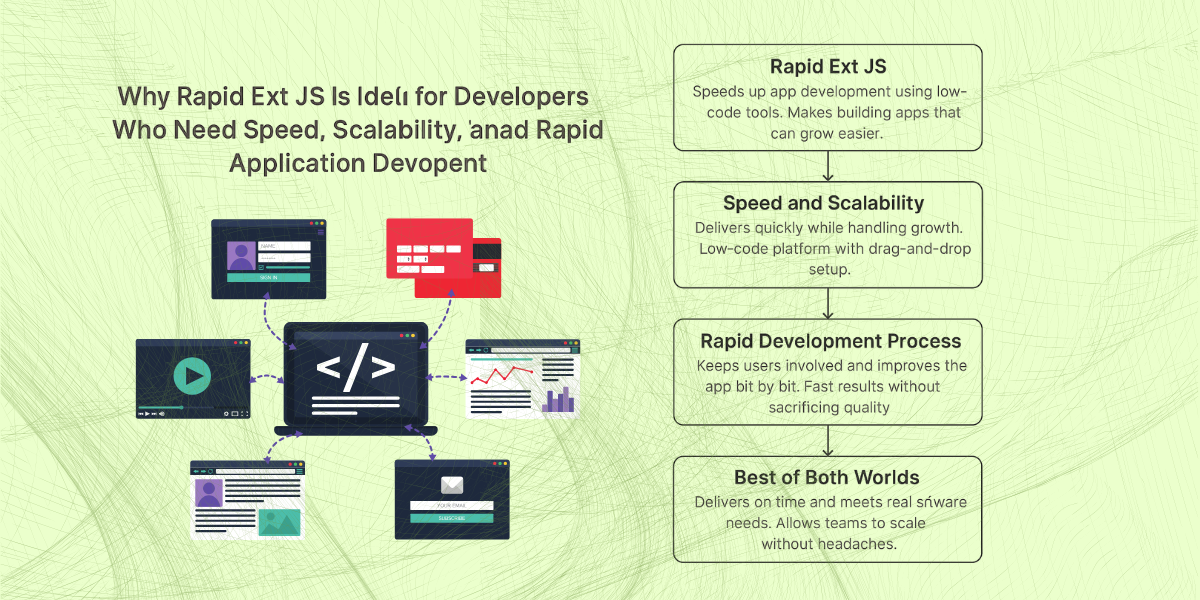Why Rapid Ext JS Is Ideal for Developers Who Need Speed, Scalability, and Rapid Application Development
Rapid Ext JS, which is an Extended JavaScript framework, speeds up app development using low-code tools. It makes building apps that can grow with your users easier. You get users involved from the start and keep improving the app bit by bit. That’s why it works so well for projects where you need things done fast but also need them to last.

Speed can make or break a project. In software development, moving fast is key. But building apps that handle growth is just as important. Developers often face a tough choice: deliver quickly or build for scale.
Rapid Ext JS changes that game. It’s a low-code platform built to speed up app building. Rather than coding everything by hand for weeks, developers can quickly drag, drop, and set up components. This approach doesn’t just boost speed; it keeps apps strong and ready for enterprise needs.
With rapid development tools like this, you get the best of both worlds. Rapid development process, built on rapid application development, keeps users involved and improves the app step by step. You get fast results without sacrificing quality or future growth.
For teams who want to deliver on time and scale without headaches, Rapid Ext JS hits the sweet spot. It’s one of the best low code development platforms that actually manages the real software needs like scalability.
What Is Rapid Ext JS?
Rapid Ext JS speeds up software development by combining visual design with full code control. It’s really helpful for developers in building, as it speeds up the process. It focuses on real user feedback throughout the process. This tool helps teams deliver updates fast without losing flexibility or quality.
Rapid Ext JS helps developers build apps faster. It is built on top of Sencha Ext JS, short for Extended JavaScript, which is renowned for being reliable and stable. Rapid Ext JS lets you design visually and tweak the code anytime.
So you get the best of both worlds – easy drag-and-drop plus the power to customize everything. So, you don’t have to give up flexibility to move fast.
The idea is to cut down the time it takes to go from an idea to a working prototype. It supports rapid application development by letting you build and tweak data models quickly. That means you can tweak the app while you’re building it, based on what users are saying. You don’t have to wait until everything’s done to find out what needs fixing.
With tools like this, you’re not stuck in a rigid build process. You can make changes on the fly as users give feedback. No need to rip apart your whole codebase. It just makes building and updating the app way less painful.
Rapid Ext JS works well for teams that want to push out updates fast while keeping quality high. It’s like having a toolkit for rapid prototyping that respects your coding style and helps you respond to user needs in real time.

Speed Up Development with Visual Tools and Prebuilt Components
Visual tools make it way easier to build your app’s interface. You just drag things into place. There is no need to write every line of code by hand. Ext JS, which is an Extended JavaScript Framework, offers many ready-made parts, so you don’t start from scratch.
This speeds up development and keeps things consistent. Real-time previews help catch issues early. It lets teams build and improve apps fast.
When you build apps using visual development tools, things get a lot faster. Instead of writing code line by line, you just drag and drop elements to design the user interface. This makes it easy to create layouts in minutes without getting stuck on details.
Ext JS comes with over 140 ready-made components like grids, charts, trees, and forms. These parts are reusable, so your team doesn’t have to build everything from scratch. Using these components helps keep the app consistent and saves loads of time.
Rapid application development, or RAD development, is about getting things done quickly and adjusting as you go. It fits well with agile software development, where you build, test, and improve in short cycles. This way, you don’t waste time planning everything up front like some other software development models.
A big plus with these rapid application development tools is the real-time preview. You can see changes right away and fix issues before they pile up. This makes rapid web app development smoother and reduces the time spent in the testing phase because problems are spotted early.
Whether you’re working on a minimum viable product (MVP) or a full app, RAD methodology supports quick iterations. It breaks down the application development into small chunks you can tackle fast. That way, the development team stays flexible and focused.
Overall, the rapid app development process with visual tools and prebuilt components helps speed up software engineering. It cuts down on repetitive coding and gives quick feedback. This means teams spend more time improving the user interface and less time stuck in slow, drawn-out processes.
Built for Speed – How Rapid Ext JS Accelerates Development
Rapid Ext JS speeds up app development with a low-code, drag-and-drop setup. It uses an iterative RAD, which is Rapid Application Development, process to improve the product in quick cycles. Live editing and automation make development faster and easier.
Rapid Ext JS is a game changer when it comes to building enterprise apps fast. It emphasizes rapid prototyping by giving developers a low-code environment. This cuts down the time needed to get functional prototypes ready.
Instead of starting from scratch, you drag and drop pre-built Ext JS components like grids, charts, forms, and layouts. This means complex workflows are easier to manage and quicker to put together.
Traditional development methods can be slow and cumbersome. They often follow the spiral model, requiring multiple iterations before getting the final product right.
The RAD approach changes this by focusing on the iterative development. You build a rough version, test it, get feedback, and then improve in the development cycle. This way, customer satisfaction rises because the product evolves with real user involvement, not assumptions.
The intuitive interface in Rapid Ext JS drastically reduces coding time. Highly skilled developers still lead the way, but they don’t get bogged down by repetitive tasks. Automated processes handle much of the heavy lifting.
So developers can focus on solving problems and customizing features. The RAD process makes it easier to keep the entire project on track without losing speed or quality.
Live editing and theme customization are built right in. You can see your changes instantly in a live production environment, which keeps the feedback loop tight. This seamless integration between design and development means bugs get spotted earlier.
Plus, it makes it simpler to adjust the app’s look and feel on the fly. All these features come together to speed up development without sacrificing control or detail.

Developer-Friendly: Why It’s Loved by Professionals
With Ext JS, your code stays tidy. That saves you time when something breaks, especially in bigger apps. It fits easily into projects and has built-in tools for teamwork. Both junior and senior developers find it useful. It consistently improves with user feedback. So, teams really work fast without compromising the quality.
Ext JS helps you keep code clean and easy to manage. It cuts down on debugging, which really helps with complex builds. When you’re working on a complex custom app, clean code really saves the day.
Adding Ext JS to your existing project is straightforward. It works well in both small modules and large scale systems without causing headaches. Skilled developers appreciate how it fits smoothly, letting them focus on actual development.
Version control and teamwork tools are built right in from the start. It saves time on setup and helps the whole team stay on the same page. That’s a huge help when you’re trying to move quickly at the start.
Ext JS works for everyone. New developers get a clear structure that helps them avoid common mistakes. Experienced developers like the control it gives for building something that can scale.
Ext JS supports a development model that blends waterfall with continuous improvement. User testing and continuous user feedback are built into the process. This approach boosts user satisfaction by making changes based on real input.
Moving fast doesn’t mean you have to sacrifice quality. Ext JS gives you speed and stability, which most frameworks don’t. That’s why a lot of devs trust it for solid, custom builds.
It keeps the team moving without dragging things down. The app runs smoothly for users, even when the project gets big. That’s what makes devs keep coming back to it.
Rapid Ext JS vs Traditional Development Tools
Traditional tools are slow and rigid; you spend more time setting up than building. Rapid Ext JS flips that with low-code tools, reusable components, and quick changes. It’s fast, flexible, and built to keep your team moving without sacrificing quality.
Building software used to mean writing everything from scratch. Traditional development tools stick to the waterfall model. First, you plan, then you build, test, and fix.
It’s slow, especially when changes pop up late in the process. You might spend weeks just setting up the environment before writing a single useful line of code.
Now compare that to Rapid Ext JS. It follows the rapid application development methodology, which moves way faster. You get a low-code interface, ready-to-use templates, and visual editors.
You can drag, drop, tweak, and move on. No need to rebuild every screen manually. Just hook in your logic and you’re good.
Maintenance is easier, too. Rapid Ext JS uses reusable components, so updates are smoother. You don’t need to rewrite the same feature again and again. That’s a huge win when you’re trying to keep things scalable without burning out.
It also gives you the best of both worlds. Want to code by hand? Go ahead. Prefer visual tools? Those are there too.
Rapid application development (RAD) focuses on speed, but it doesn’t cut corners. And since the RAD model encourages continuous feedback, teams stay in sync.
You fix issues early, test fast, and improve as you go. That’s how rapid application development actually helps in enhancing user satisfaction without the usual delays.
How to Get Started with Rapid Ext JS for Rapid Application Development
Rapid Ext JS makes it easy to start building without spending hours setting things up. You can grab the free trial, check the docs, and follow the guides without feeling lost. Start coding, test what you’ve got, and tweak things along the way.
If you’re building custom apps and want to skip the chaos of traditional methods, Rapid Ext JS is worth a look. It follows the rapid application development model, so you can get up and running fast. You won’t be stuck setting things up for weeks or fixing bugs right at the beginning.
There’s a free trial you can start with. No credit card or long forms. Just head over to the Rapid Ext JS website and hit the “Try Now” button.
You’ll also find full documentation that walks through everything, step by step. Not sure where to start? The tutorials walk you through it, step by step, with no guesswork.
They fit the rapid application development model. So you can build something, test it, and tweak things fast based on what users actually need.
This isn’t about chasing trends. It’s about using solid RAD tools that help teams move at a rapid pace without cutting corners. The framework itself becomes a key component of your entire software development methodology, helping you focus more on product logic and less on setup.
Still wondering how RAD works in real projects? Just give it a go. You’ll feel the difference once you start building.
Conclusion
When you’re building for speed without losing stability, Rapid Ext JS makes a big difference. It supports quick rollouts without skipping the critical things. A solid structure, efficient debugging, and clear user flows. Not many tools pull all that off together.
The tool’s strength lies in its support for low code development. You can move fast, build smart, and tweak things as you go. That iterative nature saves time. It’s especially helpful in the initial stages when things need to stay clear.
Real-time feedback plays into this, too. You get working software early, and that makes it easier to match user expectations. Rapid Ext JS supports the back-and-forth rhythm developers need. That’s the whole idea behind low-code application development: it keeps things flowing.
And if you’re wondering how does RAD work in this setup. It’s simple: build, test, improve, repeat.
Rapid Ext JS works well with this kind of step-by-step process. You can move faster without running into messy debugging down the line. From MVPs to full-scale systems, the platform adapts without slowing down.
It’s one of the best low-code development options out there if you care about performance and flexibility. For teams looking for maximum efficiency, low-code software like this isn’t just nice to have. It’s a critical feature.
FAQs
Do I Need Prior Experience With Ext JS To Use Rapid Ext JS?
Nope. You don’t need any past experience. The layout’s pretty straightforward, and the low-code tools take care of most of the heavy lifting. You’ll be building real apps in no time.
Is Rapid Ext JS Only for Small Projects or Can It Handle Enterprise-Level Scalability?
It works great for small projects, but it doesn’t stop there. As things grow, it keeps up. The setup handles big, complex apps without slowing down or breaking your flow.
How Does Rapid Ext JS Ensure Performance in Complex Apps?
It stays fast on its own. Most of it runs on its own. You don’t have to tweak everything by hand, even as your app gets bigger.
Is Rapid Ext JS Suitable for Building Responsive, Mobile-Friendly Applications?
Yes, it is. Rapid Ext JS comes with responsive layouts and components out of the box. Apps adjust easily to different screen sizes, including tablets and phones.
How Does the Iterative Nature of Rapid Ext JS Help Development?
You build a little, test it, make changes, then keep going. That back-and-forth really helps early on when everything’s moving fast and users expect things to just work right.
Can Rapid Ext JS Integrate With Other Tools and APIs?
Yes, it works well with APIs, backend setups, and other third-party tools. No fuss getting things connected. Whether you’re working with RESTful endpoints, JSON payloads, or custom data flows, it fits into modern stacks easily.
Does Rapid Ext JS Support Low-Code Development for Faster Delivery?
Yes. It’s built for low-code from the ground up. You can drag, drop, and set things up fast. No need to write every line. You still get all the key features.
Is Rapid Ext JS a Good Fit for Agile and Rapid Application Development (RAD) Workflows?
Definitely, its setup supports quick iterations, real-time testing, and fast deployment. That makes it perfect for agile teams or anyone following Rapid Application Development (RAD) principles.
How Does Rapid Ext JS Help With Team Collaboration?
It gives you a reliable setup, with ready-to-use parts and tools that help the whole team stay on track. Version control works smoothly, and teams stay in sync, even during fast-paced, high-pressure development cycles.
What Makes Rapid Ext JS One of the Best Low-Code Development Platforms?
It combines speed, flexibility, and power. You get clean code, enterprise-level performance, and room to scale. All with less manual work. That’s rare in low-code application development.
Try Rapid Ext JS today and build enterprise apps—faster and better!

Every software project begins with a choice that reverberates through its entire lifecycle: which development…

Building software for regulated industries demands more than functional code. Healthcare organizations must protect patient…

The Ext JS Data Grid is widely regarded as one of the most feature‑rich and…









